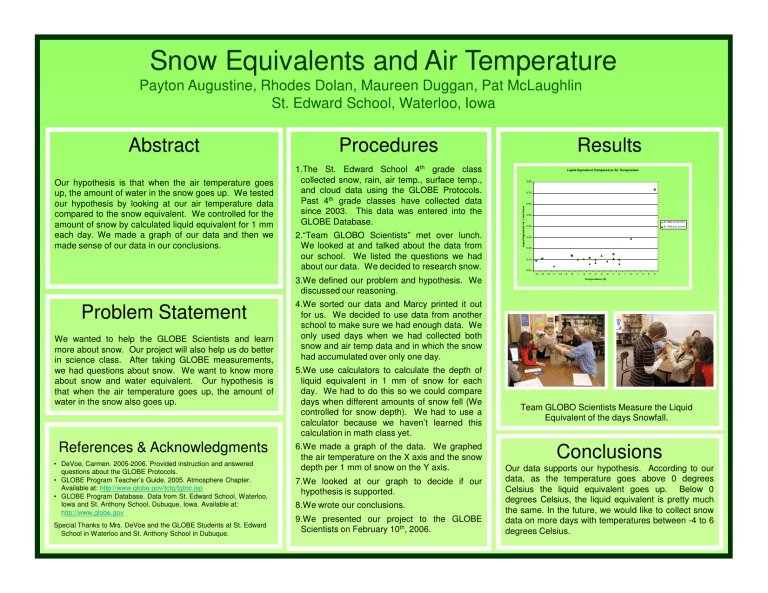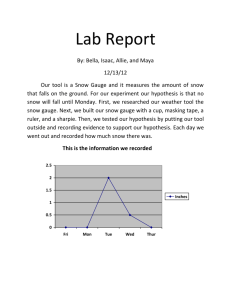Snow Equivalents and Air Temperature Abstract Procedures Results

Snow Equivalents and Air Temperature
Payton Augustine, Rhodes Dolan, Maureen Duggan, Pat McLaughlin
St. Edward School, Waterloo, Iowa
Abstract
Our hypothesis is that when the air temperature goes up, the amount of water in the snow goes up. We tested our hypothesis by looking at our air temperature data compared to the snow equivalent. We controlled for the amount of snow by calculated liquid equivalent for 1 mm each day. We made a graph of our data and then we made sense of our data in our conclusions.
Problem Statement
We wanted to help the GLOBE Scientists and learn more about snow. Our project will also help us do better in science class. After taking GLOBE measurements, we had questions about snow. We want to know more about snow and water equivalent.
Our hypothesis is that when the air temperature goes up, the amount of water in the snow also goes up.
References & Acknowledgments
• DeVoe, Carmen. 2005-2006. Provided instruction and answered questions about the GLOBE Protocols.
• GLOBE Program Teacher’s Guide. 2005. Atmosphere Chapter.
Available at: http://www.globe.gov/tctg/tgtoc.jsp
• GLOBE Program Database. Data from St. Edward School, Waterloo,
Iowa and St. Anthony School, Dubuque, Iowa. Available at: http://www.globe.gov
Special Thanks to Mrs. DeVoe and the GLOBE Students at St. Edward
School in Waterloo and St. Anthony School in Dubuque.
Procedures
1.The St. Edward School 4 th grade class collected snow, rain, air temp., surface temp., and cloud data using the GLOBE Protocols.
Past 4 th grade classes have collected data since 2003.
This data was entered into the
GLOBE Database.
2.“Team GLOBO Scientists” met over lunch.
We looked at and talked about the data from our school. We listed the questions we had about our data. We decided to research snow.
3.We defined our problem and hypothesis. We discussed our reasoning.
4.We sorted our data and Marcy printed it out for us. We decided to use data from another school to make sure we had enough data. We only used days when we had collected both snow and air temp data and in which the snow had accumulated over only one day.
5.We use calculators to calculate the depth of liquid equivalent in 1 mm of snow for each day. We had to do this so we could compare days when different amounts of snow fell (We controlled for snow depth). We had to use a calculator because we haven’t learned this calculation in math class yet.
6.We made a graph of the data. We graphed the air temperature on the X axis and the snow depth per 1 mm of snow on the Y axis.
7.We looked at our graph to decide if our hypothesis is supported.
8.We wrote our conclusions.
9.We presented our project to the GLOBE
Scientists on February 10 th , 2006.
Results
Liquid Equivalent Compared to Air Temperature
0.80
0.70
0.60
0.50
0.40
0.30
0.20
0.10
0.00
-14 -13 -12 -11 -10 -9 -8 -7 -6 -5 -4 -3
Tem perature (C)
-2 -1 0 1 2 3 4 5 6
St. Edw ard School
St. Anthony School
Team GLOBO Scientists Measure the Liquid
Equivalent of the days Snowfall.
Conclusions
Our data supports our hypothesis. According to our data, as the temperature goes above 0 degrees
Celsius the liquid equivalent goes up.
Below 0 degrees Celsius, the liquid equivalent is pretty much the same. In the future, we would like to collect snow data on more days with temperatures between -4 to 6 degrees Celsius.







